#it's such a process to make OFF-style sprites but its genuinely so much fun i might try to do some for other things sometime!
Explore tagged Tumblr posts
Text








hence nothing remains except for our regrets
sometimes you just gotta smash your interests together like playdough!!! here's the Great God Grove gods in OFF's style!
shoutout to @weirdalchemy for the sketch of Huzzle Mug's pose and a ton of help in working out the other ones!
the full-sized + unsprited sketches / some assorted rambling under the cut!
link to the bizzyboys!
turning them into little 200px max sprites lost some of the detail i really enjoyed on some of them (thespius basically lost all of his hair flowers, and bauhauzzo lost a few nice rock-chipping details i was super fond of u_u), so i figured i'd include my sketches also!








a few extra design notes from while i was trying to figure everything out
i wanted to keep Miss Mitternacht really simple, and tried to lean into the early-game boss sort of look! (i was also trying to remember how to get the sketchy-pencil texture to translate into the smaller versions, oops)
Cobigail and Inspekta were the first ones i thought of when i decided to make all of them! Cobigail's jumpscare face was an instant pick, even if i lost all of those extra little lines in the spriting process
drawing typewriters is a nightmare. people who draw Click Clack all the time at his typewriter are stronger than i could possibly imagine
i got stuck on Thespius for a while, and he was the second to last one i finished - he's a lover, not a fighter!!! i wound up sort of trying to take an angle similar to Sugar's in OFF, an optional boss who you have to deliberately go for (i have this distinct vision in my mind of a boss track for him called "Swansong")
Bauhauzzo is meant to look kind of stuck in the ground, like an obelisk!
Inspekta was taken for sort of a "busted doll" look, from that bit in the art book where they said he was animated to "move like a plushie"! he was my favorite of the bunch to work on, even if the hands were kind of a Situation
it was kind of a bummer that more of King's eye-veil didn't turn out in the sprite, but i couldn't quite find a way to make it show up without making it hide her face too much! people drawing her posing with the sword was a huge source of inspiration, though, it just felt right
i might do more of these sometime soon - maybe the Bizzyboys as a sort of group fight? i also thought about doing a Godpoke Batter type of look but i couldn't quite figure out how to finagle that, but i may try again later on!
#my art#great god grove#great god grove spoilers#i have been working on this for like four days now. oof ouch my wristssssss#it's such a process to make OFF-style sprites but its genuinely so much fun i might try to do some for other things sometime!#cw eyestrain#<- just in case those backgrounds are Too Much for some folks
963 notes
·
View notes
Note
I absolutely love the sprites you've been posting! They're so good! Do you have any tips for spriting? I'd like to get better at it, but it's not easy :'D
Thank you so much! and oh my god im so sorry for how long this took me to get to Truthfully infinite fusion helped a lot to get me into it myself haha. Not because of anything about the concept, but because it eased me into it with editing existing sprites. That way you don't have to do a lot at the start yourself yet, but you DO have to really look at how the shading is constructed to edit things together. Maybe hand draw a new leg or alter the expression a bit- again, not a ton of work, but it'll force you to deconstruct how the sprite was made to match the style!
That is probably THE best tip I can give to anyone. Find a (preferably somewhat simplistic- video game sprites r great here) style you like, and start off by working in that. Simple edits etc arent a big bang beginning, but theyre great for learning the basics.
Now for random tips I can have. Be mindful, these are just how I personally work ! Genuinely there are so many different styles and ways of working with pixel art as with any medium- you can break any rule and still have things come out amazing!
Dont worry as much about having distinct sketch/lineart/colors/shading phases. Technically you can work this way? But I find it makes me focus too much on how each individual phase looks when most of the time (at least for me) a sprite doesnt pull together until the very end. it WILL look slightly mad until then its simply part of the process. I tend to put a rough base with some beginning colors and then simply refine from there. wips vs finished attached below for visuals
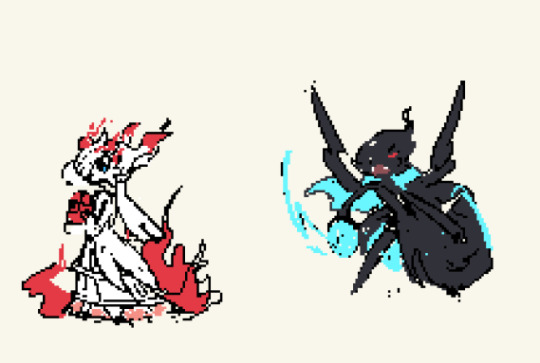
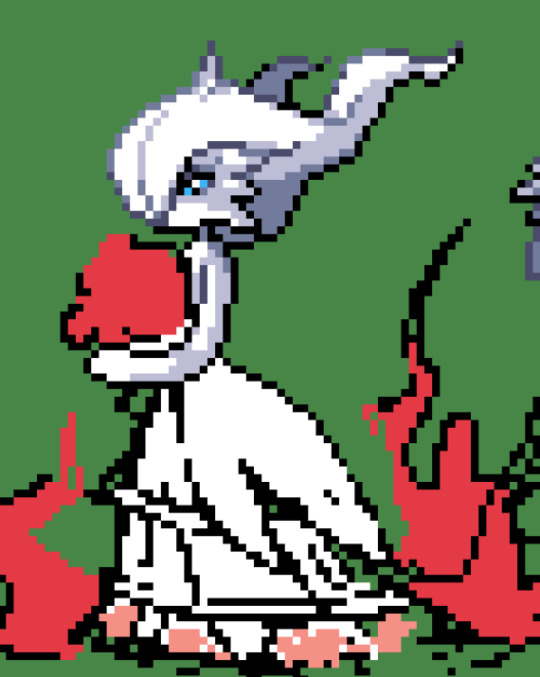
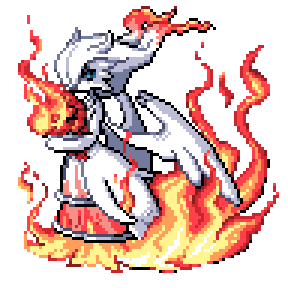
Also, careful with stuff like dithering! It can be very fun , and some styles have a ton of it which works fine and can look good! But from what I can see at least in the IF disxord a lot of ppl will slap it on anytime anywhere at the start which makes things look... messy. I personally mostly use it for fabrics. (Also, get a dithering brush. Love yourself, dont do that by hand, especially on bigger sprites)
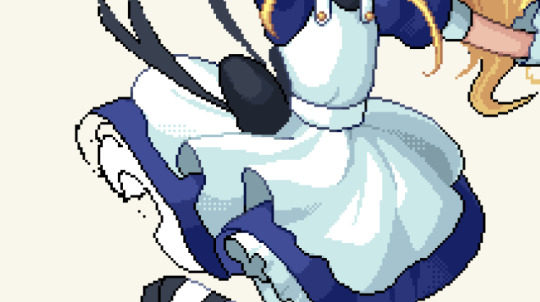
Limit your colors! This is a general tip and not tehcnically that important, but I find it really helps me.
I tend to stick to 3/4 shades per color max. Some of the darkest shades of a color can also be the lightest parts of the outline for that color! Pic below I used the browns not just for the hair, but also for the gold shading and for the darker parts of the skin. It just helps pull a pallete together easier when youre reusing it where you can.

Dont be afraid of using the outlines color to shade with either for dark shades btw ! It is fun it is fresh

Only real warning for outlines Ive got is to be careful of jaggies. Like the upper line reads 'smoother' then the lower one because the longer pixels all follow eachother gradually. Jaggies can be useful especially in folds and whatnot, but when something is supposed to look smooth or round- no jaggies usually show!

12 notes
·
View notes
Text
Is Mortimer Beckett and The Book of Gold Really That Bad?
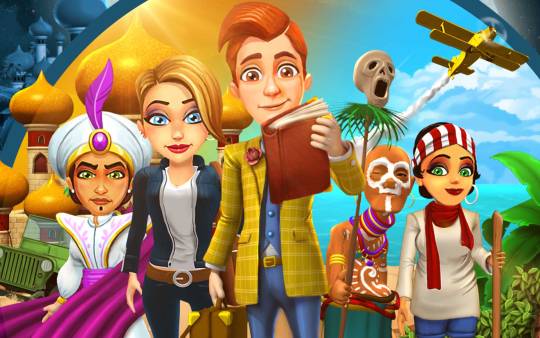
(Full disclosure: this post contains mild spoilers for discussion’s sake.)
So I am a big fan of the Delicious series and the many spin-offs that have launched from its universe, now formally known as GameHouse Original Stories. Yes, they sometimes seem like they’re hyper-marketed at that Hallmark Channel crowd, but they are the cream of the crop of modern casual games, I promise. That said, not every game that comes out of GameHouse Studios is a masterpiece. But just because it’s not a masterpiece doesn’t mean there isn’t good to be found or fun to be had.
Enter Mortimer Beckett and The Book of Gold, released in 2017. For those unaware, Mortimer Beckett was not originally a GameHouse IP, instead starring in his own series of hidden object games developed by Paprikari from 2007 to 2012. I played the first in the series, Secrets of Spooky Manor, and dabbled with others, but I am by no means an aficionado on Mortimer Beckett lore. Actually, I’m not big into the hidden object genre period. I can tell you, though, that this game feels very different to the traditional Mortimer Beckett series. Paprikari still worked as the developer for Book of Gold, but the overall style and flavor is extremely influenced by GameHouse.
I can only assume GameHouse acquired permission to use Mortimer’s character around the same time they acquired Sally from GamesCafe’s Sally’s Salon series. These were two fairly well-known faces in casual gaming for many years, and for those characters to suddenly be picked up by a new company and breathed new life was a strange move to witness.
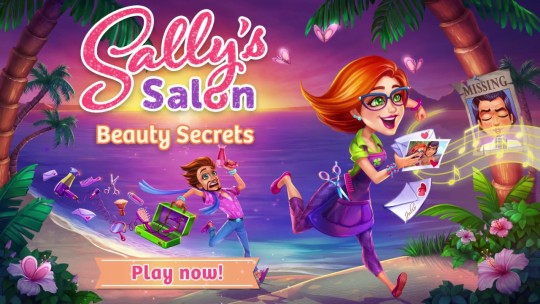
Not to say it was a bad one. I was an am a dedicated Sally fan and Sally’s Salon - Beauty Secrets blew my expectations out of the water.
Book of Gold on the other hand...well, that’s why we’re here.
Before I even played the game, the first things I noticed were the consistently negative ratings it received across distributing websites. Now all things considered, I wasn’t expecting perfection, but these scores were abysmally low. I thought, “it can’t be as bad as that, right?”
And after playing through the whole thing in one night, I will proudly go on record to say that this game does not deserve these low ratings.
Buuut it’s not perfect, either.
So let’s talk.

First, the elephant in the room - the gameplay itself. As previously stated, Mortimer Beckett is a hidden object series. GameHouse is best known for their time management games that occasionally have hidden object mini games sprinkled through the levels. Mini games and main gameplay mechanics are two very different things, mind you.
That said, I think the translation of the gameplay went very well. Better than I was expecting, at least. You’re given a scene in which you must find pieces of different objects that will help you in your current situation. Then, once those pieces are put together, you can use those objects in the scene to complete small puzzles. Even with my limited hidden object experience, I can tell that this style of finding pieces of things is quite unique.
In fact, this was my biggest complaint back in Secrets of Spooky Manor: the pieces that some objects broke into seemed arbitrary and unnatural, making it harder to find what I was looking for. In Book of Gold, the objects are broken up where they naturally have different “sections” (for example, if you’re looking for a screwdriver, it would be in two separate pieces: the handle and the bit) and gameplay is smoother as a result.
There are also three different kinds of challenge levels throughout the game in which you have to complete certain tasks within a time limit. These provide a nice sprinkle of adrenaline rush as the main levels have no time limit and you’re welcome to stare at and contemplate them as long as you wish. So all in all, the gameplay is pretty solid.

Let’s discuss the plot. Mortimer Beckett moves to Snuggford after inheriting a museum from his Uncle Jerome (a staple character of the series until now, I understand). In his last letter, Uncle Jerome mentions something called the Book of Gold which apparently possesses mystical qualities, and warns Mortimer to keep it safe.
Even as someone with very little preexisting attachment to this character, I found Mortimer very charming and enjoyable, in that “I don’t really know what I’m doing but I’m going to make the best of it anyway, and probably embarrass myself in the process” kind of way. It was also refreshing simply to play as a guy, as GameHouse Original Stories pretty much exclusively feature women protagonists.
Speaking of which, while this is happening, Kate O’Malley (Delicious Emily’s sister-in-law) is having something of a life crisis and desperately looking for some kind of adventure to get her out of her “boring” hometown.
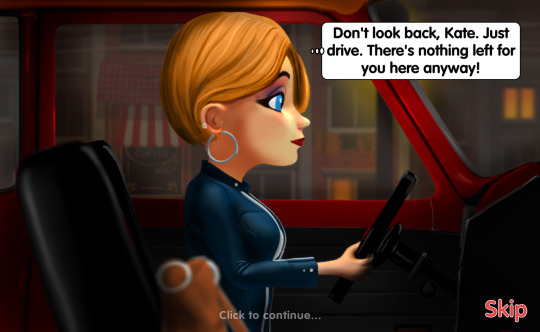
This is good for two reasons. One: Kate is a character seen very little of in the Delicious series. Other than she’s Patrick’s sister and she used to work as a perfume salesgirl, we didn’t know much about her until Book of Gold. The writers really gave her some agency this time around, where previously she felt kind of cardboard. And two: Snuggford is often viewed as a very idyllic small town with emphasis on supporting local businesses and fostering community with others. It’s oddly refreshing to see a protagonist character have a negative view of this place.
Anyway, the two run into each other, shenanigans ensue, and an adventure does indeed begin.

Now if GameHouse is known for anything besides time management gameplay, it’s their heterosexual romantic subplots. And as much as I was hoping for a platonic partnership this time around, I have to say I ended up liking Kate and Mortimer more than I expected. It is a bit tropey and shoved down your throat at times, but I think their personalities play off each other quite nicely - Mortimer the somewhat bumbling scholar and Kate the confident risk-taker. In the end I was genuinely rooting for them.
The story itself as a whole is...fine. Not amazing, not terrible, but fine. It has good intentions but, as I said, falls into tropes and shenanigans rather than raising the stakes. And when the stakes are raised, it fails to explain why and generally lacks urgency.
The best parts of the story in my opinion are the more character-driven scenes. Stemming from Kate’s desire for adventure, there is an underlying emotional theme about whether or not you’re satisfied with your life and where you are in it. I think this is handled better than the immediate plot, but could still use some tweaks. Overall, the writing has the same wonkiness I would expect from any story that hasn’t truly found its groove yet, but it does enough to keep you intrigued.
I absolutely cannot knock GameHouse for trying to do something new, especially in this cash cow of a universe they’ve built for themselves. They’ve been using basically the same formula for the past ten years or so, and it makes sense that they would want to branch out into other things while still attracting their core audience.
Unfortunately, this game has some very apparent growing pains.

My biggest issue without a doubt is the art. It’s inconsistent, there’s no other word for it. Some sprites are completely 2-D, others are completely rendered in 3-D. Sometimes it’s 2.5-D. Sometimes it’s 2-D heads stitched onto 3-D bodies. Some characters look very disproportionate when standing next to others. Not to mention a lot of reused assets from other games. I can’t show it for spoiler reasons, but there is a scene near the very end of the game where the character cutting-and-pasting is so painfully obvious and so sloppily done that I almost had to close my computer and take a lap around the house to compose myself.
Also, this game has far less music than I expected. Despite a swingin’ noir-style theme song written by Adam Gubman, most cutscenes carry out with only generic background white noise for company. And let me tell you, when a dramatic scene is going down and the only thing you can hear is the muffled voice of an airport intercom? It feels wrong. And also lends to that lack of urgency I mentioned earlier.
And as much as I hate to, we have to talk about the “exotic” themes.

For the most part, I would describe GameHouse as having “lukewarm sensitivity” to cultures that are not North American or European. They have good intentions and for the most part their characters are pretty well rounded, but their research still leaves a little bit to be desired. I think the Inuit tribe from Delicious - Emily’s Hopes and Fears is the best example of what I’m talking about.
However, I would not put Book of Gold in that same sensitivity tier. During the third chapter, Mortimer and Kate travel to South America (it’s never specifically stated but since Machu Picchu is clearly visible in one of the scenes, it’s pretty safe to say they’re in Peru) and end up getting lost in the jungle. Kate is more or less kidnapped by a group of natives, whose leader speaks what can only be described as “cave man English” and invites her to join his harem. When she refuses, he threatens to kill her if she doesn’t complete the puzzles set before her. Then, when Kate manages to escape, the tribe leader leans over to one of his guards and says, “Those tourists are so gullible,” indicated that it was all an act. I still have no idea what to think about this entire section.
There’s also a great deal of Arabian influence in the second half of the game, as the main villain claims to be a sheikh, but I would say that it’s more there for visual interest than anything else. The side characters you meet in this arc aren’t particularly memorable, and aside from avoiding a sandstorm and racing camels at one point, the desert setting is just kind of...there. It’s not as bad as it could have been, but it certainly wasn’t doing the game as a whole many favors, either.
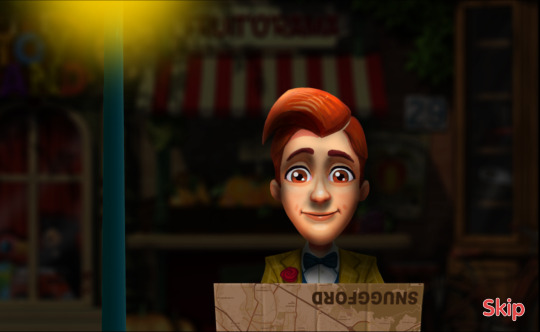
To wrap this up with a bow, if you disliked this game simply because it was different and not the “signature GameHouse experience” you’ve come to expect, I feel sorry for you. If you disliked this game because it doesn’t feel as polished as it could have been and the graphics are a bit of a train wreck? Yeah, I get you. But I still found this game enjoyable despite its flaws. And if you’ve been avoiding this game because the bad ratings scared you off, pull on your big girl panties and manage your expectations.
I really hope that GameHouse sees Book of Gold as a learning experience and not a failure, because I think there’s some genuine potential here. With some tweaks and polish (and clearer art direction), I would happily accept another game like this.
#mortimer beckett#gamehouse#gamehouse original stories#hidden object games#game review#original article
5 notes
·
View notes
Text
Video Game Year in Review: The Top 10
As with any year-end list, this one probably isn’t complete. Last year, I fell in love with Nioh over winter break after I had already made my top 10, and just a few days ago, I started playing Hollow Knight. As I made clear in my previous lists, Metroidvanias can be hit or miss for me. I can get fed up with wandering around without a clear destination, and Hollow Knight has a bit of that so far, but it also has one of the most atmospherically welcoming settings for a video game in recent memory, and so far I’ve been pretty damn enraptured by it. I’m not too worried about it making the list at this point; it didn’t even technically come out this year anyway, but its Switch release earlier this year gave it somewhat of a second debut, for all the earned attention it finally got. At least I got a little shout-out here before publishing.
Anyway, here’s ten games I loved the shit out of in 2018. This was one year with a handful of games that I absolutely adored, none of which necessarily immediately jumped out to me as hands down the best one of the bunch, and honestly, that’s the way I’d prefer it, but it did make ranking them a bit tough. Really, from number five onward, the ranking gets pretty interchangeable. I didn’t plan on the game in my number one spot being the one that it is until I actually wrote out my feelings for it and decided that out of all them it was the easiest for me to just gush about. Alright, no further ado:
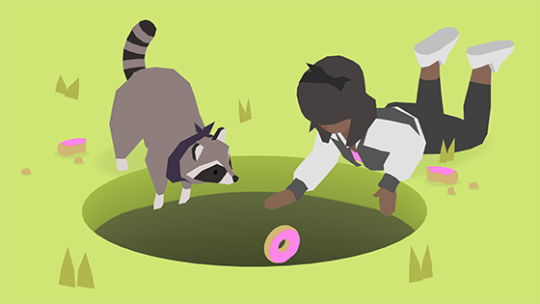
10. Donut County - Overall, it’s probably a good thing that Donut County isn’t longer than it is, but for as mechanically simple as sucking objects into an ever-expanding void is, it’s something that I felt I would’ve been perfectly entertained doing for a lot longer than the game lasted. Donut County has a wildly inspired and novel central gameplay hook, a relatably goofy sense of humor that might border on obnoxious if it weren’t so sincerely delivered, and an anti-gentrification, anti-capitalist message that mostly works without beating you over the head too hard with it. Ben Esposito and his team have created one of the most charming and original games I’ve played in years here.

9. Paratopic - “Cinematic” is a grossly overused and frequently inappropriate word to use in games criticism, but this game often had me coming back to the word, observing how many ways it feels like it authentically takes inspiration from creative methods seen more often in film, particularly art films, than in games, much more so than say, Red Dead Redemption 2, which typically embarrassingly pales in comparison to any movies it’s obviously aping from. There’s its willingness to not explain to you what’s going on, letting you pick up on clues from scenery and incidental dialogue. Its multiple switching perspectives, laced together to draw meaningful narrative connections. Its tendency to sit in the atmosphere of a scene. Its ability to tell a succinct story intended to be experienced in one sitting. And most of all, those jump cuts. I know Paratopic isn’t the first game to employ this technique, but as far as I can remember, it’s the first that I’ve played to utilize them for purposeful artistic effect, and every time it happened, it was oddly thrilling. I loved when I’d switch from walking to suddenly driving, and had a moment of panic, as if I suddenly just woke up at the wheel. The cliffhangers scenes would occasionally end on made me desperate to get back to that thread. Hell, even just the fact that there clearly were scenes, that lasted a few minutes at a time, then moved on to the next one, felt weirdly refreshing at a time when AAA design is becoming so absurdly bloated. Paratopic excited me, not in its desire to emulate a separate art medium, but in its casual realization of how many underutilized narrative techniques work genuinely effectively in this medium.

8. Dusk - I really can’t imagine a game that more perfectly matches my Platonic ideal of “video game comfort food” than Dusk, aside from, maybe, the game in the number one spot of this list. I was raised on 90’s PC FPS games like Doom and, as is much more relevant to this game, Quake. Yeah, for the most part, it’s nice that games have moved on, both in depth of gameplay and artistry, but goddamn does a back-to-basics twitchy shooter with inspired level design and creepy atmosphere just feel good sometimes. The grainy, chunky polygons of this game encapsulate everything I love about the rudimentary but remarkably evocative minimalism of early 3D graphics. The movement feels absurdly fast by modern standards, and the effect is thrilling - every projectile is dodgeable, as long as your reflexes are sharp enough. Undoubtedly the most impressive thing about this game is its ambitious level design, so much of which rivals even John Romero’s. The longer this game goes on, the more sprawling and labyrinthine it becomes. The map shapes become increasingly wacky. The gothic architecture becomes more foreboding and awe-inspiring. Dusk does a lot with a little, and in the process, makes so much more than a tribute to game design and aesthetics of the past - for me, it stands right alongside its obvious inspirations as one of the very best of its ilk.
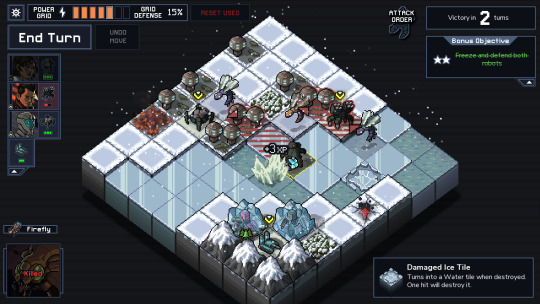
7. Into the Breach - An absolute masterclass of game design. Into the Breach leaves nothing about its mechanics obscured, making sure you understand how every move is going to go down just as well as it does, and the fact that the result is still compellingly challenging is a sure sign we’re in the hands of remarkably skilled and intelligent developers. The narrative in this game is sparse - you assume the role of time-looping soldiers attempting over and over again to save your world from alien invasion (think Edge of Tomorrow), and that’s pretty much all you get for the plot, aside from some effective but minimal character beats and dialogue one-liners. And yet, every battlefield, a small grid with its own arrangement of sprites (giant creepy-crawlies, various creative mech classes, structures full of terrified denizens given a modicum of hope at the arrival of their ragged potential saviors) offers a playground for drama to unfold, as gripping and epic as any great mecha anime battle. As I mentioned in my previous list with Dead Cells, I have trouble sticking with run-based games, and this game wasn’t quite an exception - honestly, if it had something resembling a more traditional narrative campaign, I could see it potentially filling my number one spot. But that a game of its style nevertheless stuck with me as well as it did proves what a tremendous achievement I found it to be.
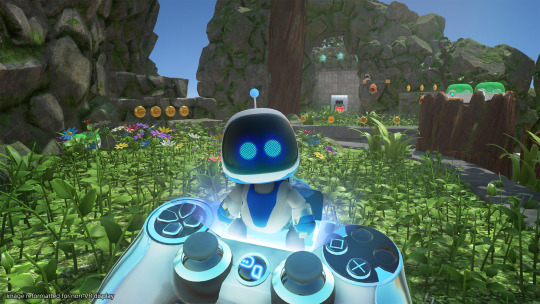
6. Astro Bot Rescue Mission - This was both the first game I’ve played fully in VR and the first game I’ve ever platinumed. I guess that might say something about how thoroughly I fell for it. For some reason, one of the questions that my brain kept posing while playing this game is, “would you like this game as much if it weren’t in VR?” I would like to pose that first off, if this wasn’t a VR game, it would be quite a different game, but yes, probably a perfectly delightful 3D platformer in its own right. But most of all, this game helped me realize what a bullshit question that is in the first place. By virtue of its VR nature, this game is just fundamentally different, just as the jump from 2D to 3D resulted in games that were just fundamentally different. The perspective you’re given watching over your little robot playable character allows to look in 360 degrees, and often you need to, if you’re seeking out every level’s secrets, and yet, while it moves forward, it doesn’t follow you vertically, so sometimes you’re looking up or down as well. It’s difficult to describe exactly how this perspective is so much more than a gimmick or something, outside of the cliched exaggeration of “it feels like you’re really there, man,” but honestly, this statement isn’t wrong. I truly did feel immersed in these levels in a way that I wouldn’t have if this weren’t a VR game, and while it’s not exactly a feeling I now desire from every game, it does stand out as one of the singular gaming experiences I had in 2018 as a result.
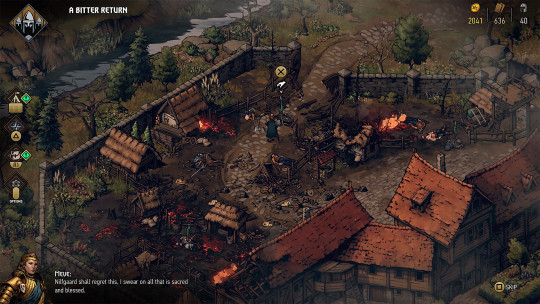
5. Thonebreaker: The Witcher Tales - I gushed plenty about this game in my review. How its approach to Gwent-based combat is both welcoming to newcomers and remarkably varied, offering new ways to approach and think about the game with nearly every encounter. How its sizable story is filled with fascinating characters and genuinely distressing choices, forcing you to grapple with the inherent injustices of your position. How its vivid art style and wonderfully moody Marcin Przybyłowicz score sell The Witcher feel of this game, despite how differently it plays from the mainline entries of the game. And maybe most of all, how criminally overlooked this game has been. So I’ll make the same claim I did before - if The Witcher 3: Wild Hunt did something for you, it’s likely this game will too. Don’t worry about the card game - I did too, and trust me, it’s fun. It’s the new Witcher game; that really ought to be all you need to know.
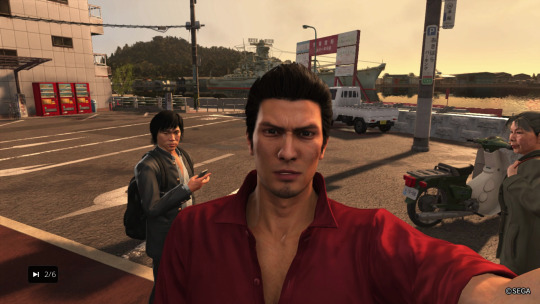
4. Yakuza 6: The Song of Life - There’s...a lot about the Yakuza games that I’ve come to adore, but one of the biggest ones that kept sticking out to me while playing The Song of Life is how they build a sense of place. After playing Yakuza 0, set in 1988, and Yakuza Kiwami, set in 2005, I played this one, set in 2016. Each time, same Kiryu, but older, same Kamurocho, but era appropriate. Setting every Yakuza game in the same map has to be one of the quietly boldest experiments in video games, forgoing fresh new vistas to explore in favor of the same familiar boulevards, alleys, and parks of the iconic red-light district, painting an exquisitely detailed and loving portrait of a neighborhood changing with the decades. While Kiryu’s exasperation at once again walking into the all-too-familiar crowded streets of Kamurocho, brighter and louder than ever, hardly matched my eagerness to see how it had changed, it felt appropriate. Though he’s still the hottest dad (grandpa?) in town, he is kinda old now, and he’s certainly earned the right to just be over it a little. Even the silliest of the era-relevant sub stories (one of which delightfully features Kiryu putting a selfie-stick wielding, obnoxious-stunt pulling, wanna-be influencer shithead in his place) serve to underscore how out of place he now is in his old stomping grounds.
By contrast, the other setting of Yakuza 6, the quaint seaside town of Onomichi, very quickly begins to feel like an idyllic retirement destination. The introduction to this part of the game has to be my favorite video game moment of 2018 - Kiryu trying to calm a hungry baby, while walking the deserted streets after dark in search of one store that still happens to be open. The faint sound of ocean in the distance effectively evokes the freshness, the bitterness, of the air. The emptiness and darkness of the space is almost shocking, compared to the sensory overload of Kamurocho. And there’s Haruto. Kiryu took Haruka in when she was 9, so he’s never had to deal with a baby before. He’s out of his element, but hardly unwilling. The help he gets from Kiyomi and his other new friends is the kind of comfort Kiryu needs at this point in his life. Likewise, the events in Onomichi play out like a retirement fantasy - building an amateur baseball team out of local talent, building relationships with the denizens of a bar in an incredible Japanese version of Cheers, hanging out with the town’s Yakuza, who are so small potatoes they seem to barely fit the definitions of organized or crime. It all works beautifully as a touching send-off to my favorite video game character.
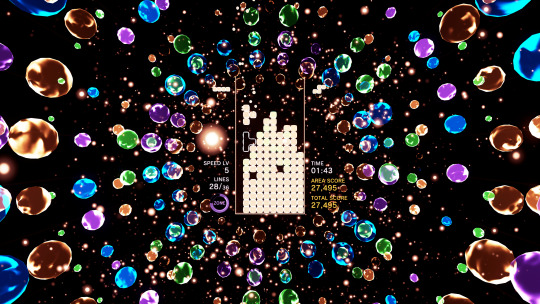
3. Tetris Effect - There was a long time where I was contemplating putting this as my number one game. I went through some strange conflicts in the consideration - next to all these original, thoughtful games, am I really going to say that fucking Tetris is best one of them? Is that even fair? Is this game really anything more than just regular-ass Tetris but with some pretty lights and sounds and a 90’s rave kinda vibe? The answer to all of these, is, of course, yes, but also no. I’d defend my choice any day, though. This is the first game to actually get me into Tetris. I always appreciated it; it’s a classic, but it was never a game I had actually put much time or thought into before. This game not only sold me on Tetris, but got me obsessed with it, to the point where the name feels remarkably appropriate: ever since I began playing, I’ve been seeing tetriminos falling - in my sleep, in daydreams, any time I see any type of blocky shape in real life I’m fitting them together in my mind. The idea that all Tetris pieces, despite their differences, need each other and complement each other and can all fit together in perfect harmony, and that this is a metaphor for humanity, has to be some of the cheesiest bullshit I’ve ever heard, and yet, the game fully sold me on it from the first damn level. It’s all connected. We’re all together in this life. Don’t you forget it.
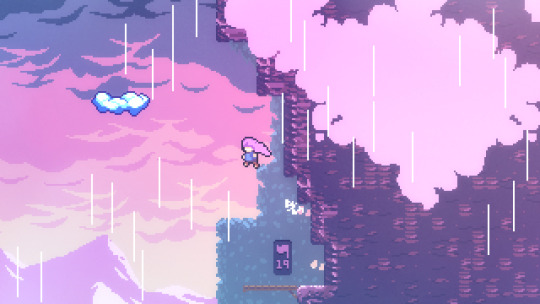
2. Celeste - This is a damn near perfect game, both as refreshing and demanding as a climb up a beautiful but treacherous mountain ought to be. I died many, many times (2424, to be exact), but the game explicitly encouraged me to be proud of that, acting as a friendly little cheerleader in between deaths, assuring me that I could do it. It’s both a welcome break from the smug, sneering attitude so many “difficult” games tend to traffic in, and absolutely central to its themes involving mental health. As the shockingly good plot starts making it increasingly clear that it’s about Madeline’s quest to conquer (or, at least, understand) her inner demons, the gameplay itself offers a simple but effective metaphor for struggling with mental illness - yes, it’s hard, and yes, you’re going to suffer and struggle, but you can make it, and you will make it, because you’re so much better than you think you are. Oh, and also, it’s not all bad, because at least you get to listen to some absolutely rippin’ tunes while you do it.
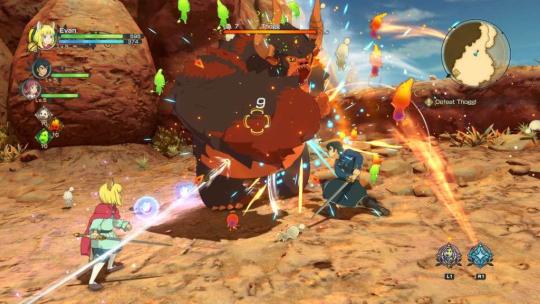
1. Ni No Kuni II: Revenant Kingdom - (Another one I reviewed!) This is my ideal JRPG. In my mind it stands next to childhood treasures like Final Fantasy IX. Unlike some recent Square projects that specifically try to clone their late 90’s output, this game hardly feels beholden to the game design of the past, and yet, feels of a piece with that era in a respectably non-cloying way. It has a bright, colorful, inviting world full of charming characters, an all-time great soundtrack by Joe Hisaishi, and an exciting, deep combat system with an emphasis on action. Building my kingdom of Evermore was remarkably satisfying, down to all the little dumb tasks my citizens would ask of me, none of which my very good boy King Evan was too busy or too proud to refuse. There’s very little grinding. It’s a long game by most standards, but at 40-something hours, it feels lean by JRPG standards. And for as much of a storybook fantasy as the plot is, as much as it reduces woefully complicated socio-political issues into neat, resolvable tasks for Evan to solve, it always came across as perfectly genuine, and sometimes surprisingly affecting. It’s the game that I’ve wanted to play since the PS1 Final Fantasy games stole my heart as a kid. That’s hardly what I expected it to be as I started into it, and what a joy it was to discover that it was.
#Ni No Kuni#Ni No Kuni II#Ni No Kuni II: Revenant Kingdom#Celeste#Tetris#Tetris Effect#Yakuza 6: The Song of Life#Yakuza#Yakuza 6#Thronebreaker#Thronebreaker: The Witcher Tales#The Witcher#Astro Bot#Astro Bot Rescue Mission#Into the Breach#Dusk#Paratopic#Donut County#Review#List#Game of the Year#GOTY#Top 10#game#Games#video game#video games#criticism
5 notes
·
View notes